A report on the proceedings of the
National Conference on Air Pollution and Climate Change
January 31, 2023
Organised by

Report prepared by
Mala Balaji (Researcher, Environment & Climate Action, CAG)
Shankar Prakash (Researcher, Environment & Climate Action, CAG)
Madhuvanthi Rajkumar (Researcher, Environment & Climate Action, CAG)
Acknowledgements:
The authors acknowledge Vamsi Shankar Kapilavai and S. Saroja for their critical review of the report and Benedicta Issac for editing the report.
National Conference on Air Pollution and Climate Change
Session 1: Air pollution & climate change - 2 sides of the same coin
- Nexus between air pollution and climate change - A multifaceted problem - Mr. Bhasker Tripathi, Freelance journalist.
- Socio-economic issues in Non-Attainment Cities - Mr G. Sundarrajan, Poovulagin Nanbargal.
Session 2: Suffocating Indian cities
- Vehicular emissions - Mr. Anirudh Narla, International Council on Clean Transportation.
- Industrial pollution in coastal cities - Ms. Gandhimathi, Coastal Action Network.
- Waste(full) cities - Ms. Sumana Narayanan, Citizen consumer and civic Action Group
Session 3: Indian policy responses to Air Pollution
- CPCB Action plans in NAC - Dr. Ethirajan,TNPCB
- Viewing air pollution and policies through the gender lens - Ms. Pallavi Pant, Health Effects Institute
- Status of implementation of NCAP and roadblocks - Mr. Sunil Dahiya, Centre for Research on Energy and Clean Air
- Securing India's database for AP - Dr. Pratima Singh, Centre for the study of Science, Technology and Policy
Session 4: Sustainable solutions for Air Quality Management
- India’s AQM - pollution prevention and control infrastructure - Dr. Abinaya, Centre for Policy Research
- Zero waste cities - Mr. Shibu Nair, Global Alliance for Incinerator Alternatives
- Transition to renewables - Ms. Bhargavi Rao, Environment Support Group
- Sustainable mobility to combat air pollution - Mr. Ranjit Gadgil, Parisar
Session 5: Sustainable citizen accounts
- Ms. Janani Venkitesh, a Resident of Kasturbanagar Association (ROKA)
- Ms. Nina Sumbramani, Warrior Moms
- Mr. Suresh, Environmental Enthusiast
Welcome address
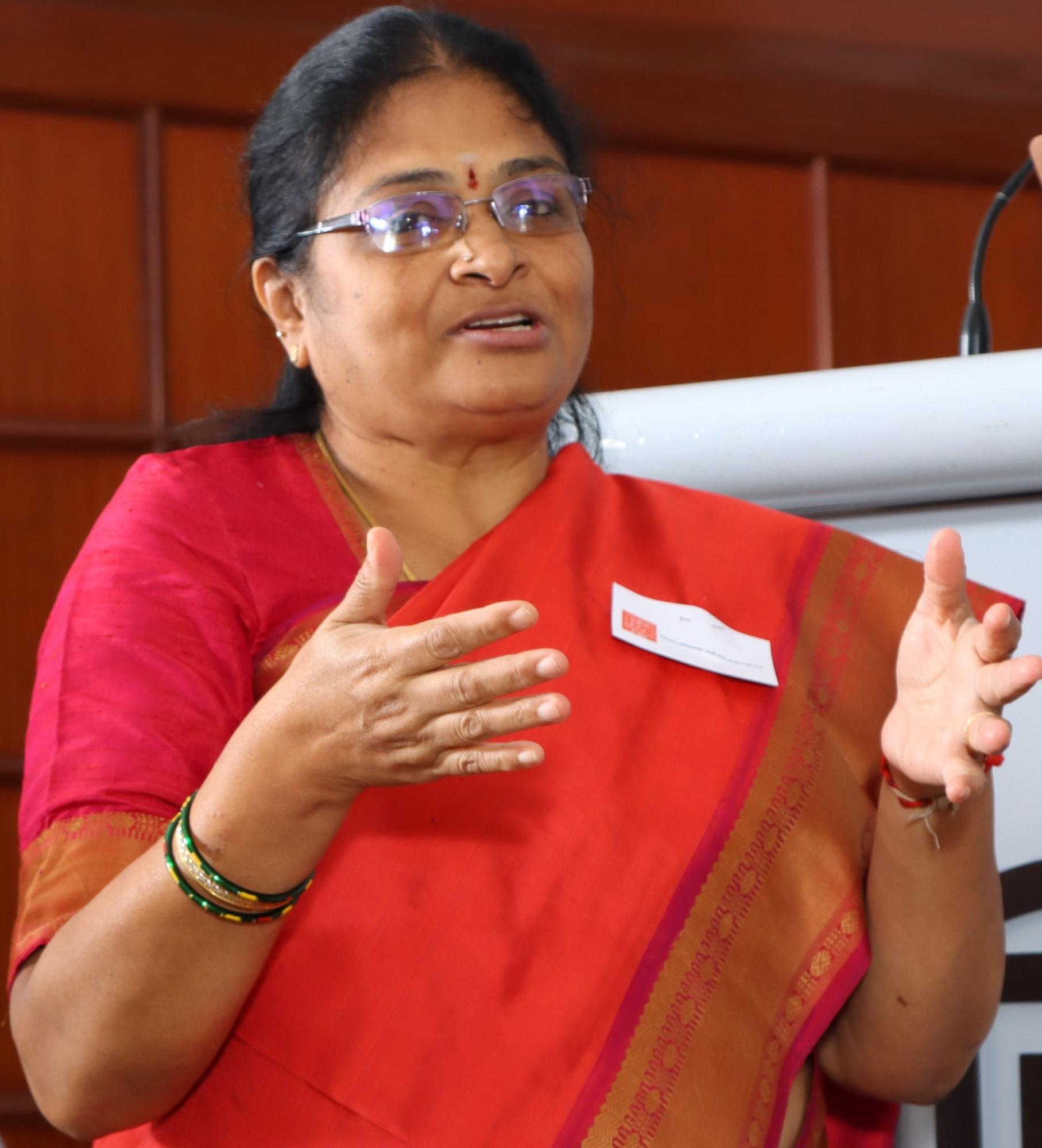
Ms. S. Saroja
Executive Director, Citizen consumer and civic Action Group
The conference began with Ms. Saroja, Executive Director of Citizen consumer and civic Action Group (CAG), extending a warm welcome to the chief guest, speakers, members of the press and the audience. She began by highlighting India’s position as the infamous front-runner in air pollution related deaths. She touched upon the disproportionate loss and damage due to climate change in developing countries and how 95% of deaths caused by air pollution occur in developing countries. She explained why air pollution cannot be seen as one individual complication of our frenzied lives but instead should be seen as going hand in glove with the climate crisis. She hoped that the discussions would aim to explain and understand how we can intervene at the various stages of the vicious air pollution - climate change cycle in such a way as to mitigate their cumulative effects on humankind. She concluded that the conference would pave the way for government officials, civil society, academia, industry and underrepresented groups to come together to understand the problems from the ministerial to institutional to the grassroots level; and help us come together to derive a holistic approach to control air pollution and mitigate climate change effects.
Keynote address

Mr. Deepak Bilgi I.F.S,
Department of Environment & Climate Change, Government of Tamil Nadu
Mr. Deepak Bilgi I.F.S, Director, Department of Environment & Climate Change, Government of Tamil Nadu, delivered the keynote address. He stressed the importance of concerted action by governments, stakeholders and the public towards controlling air pollution and mitigating climate change impacts. He explained that the ultimate aim of the climate change mission should be to create intrinsic changes in human behaviour. While air pollution is primarily seen as a public health issue, he highlighted that the deterioration of public health and loss of the labour force will impact the country’s economy. Therefore, in addition to being seen as an ecological problem, climate change should also be viewed as a serious economic one.
Launch of CAG’s textbook on climate Change - Facts on Climate Change Unravelled for Students ( FOCUS)
Following the keynote address, Mr. Deepak Bilgi, Mr. Ashok Varadan Shetty, IAS (Retd) -Trustee, CAG, and Prof. Sultan Ismail, Member, State Planning Commission, Tamil Nadu were invited on stage to launch FOCUS (Facts on Climate Change Unravelled for Students), CAG’s textbook on climate change for middle school students. During the launch, Ms. Mala Balaji gave a summary of how the textbook is a part of CAG’s project to introduce climate change within the middle school curriculum. The textbook is already in its pilot phase in select schools in Tamil Nadu. Ms. Mala explained the research and processes that went into compiling the textbook and that on completion of the pilot phase, CAG will request the government that it be introduced as a part of the regular school curriculum.

Launch of CAG’s textbook, FOCUS, on climate change
CAG’s work on Environment & Climate Action

Ms. Mala Balaji
Researcher, Citizen consumer and civic Action Group
Ms. Mala Balaji, Researcher, Environment and Climate Action at CAG, presented on CAG’s work in the Environment and Climate Action space. She explained the rationale behind CAG’s work in protecting eco-sensitive areas and promoting transparent decision-making by the government. CAG's Thermal Watch Initiative aims to educate local communities and NGOs about the regulatory and administrative processes for industrial activities and to build capacity for a more people-centred, clean-energy future. Ms.Balaji added that CAG is committed to empowering local communities and promoting stricter compliance with environmental protection requirements. Mr. Shankar Prakash, Researcher, Environment and Climate Action then gave an overview of CAG's work on air pollution and climate change.
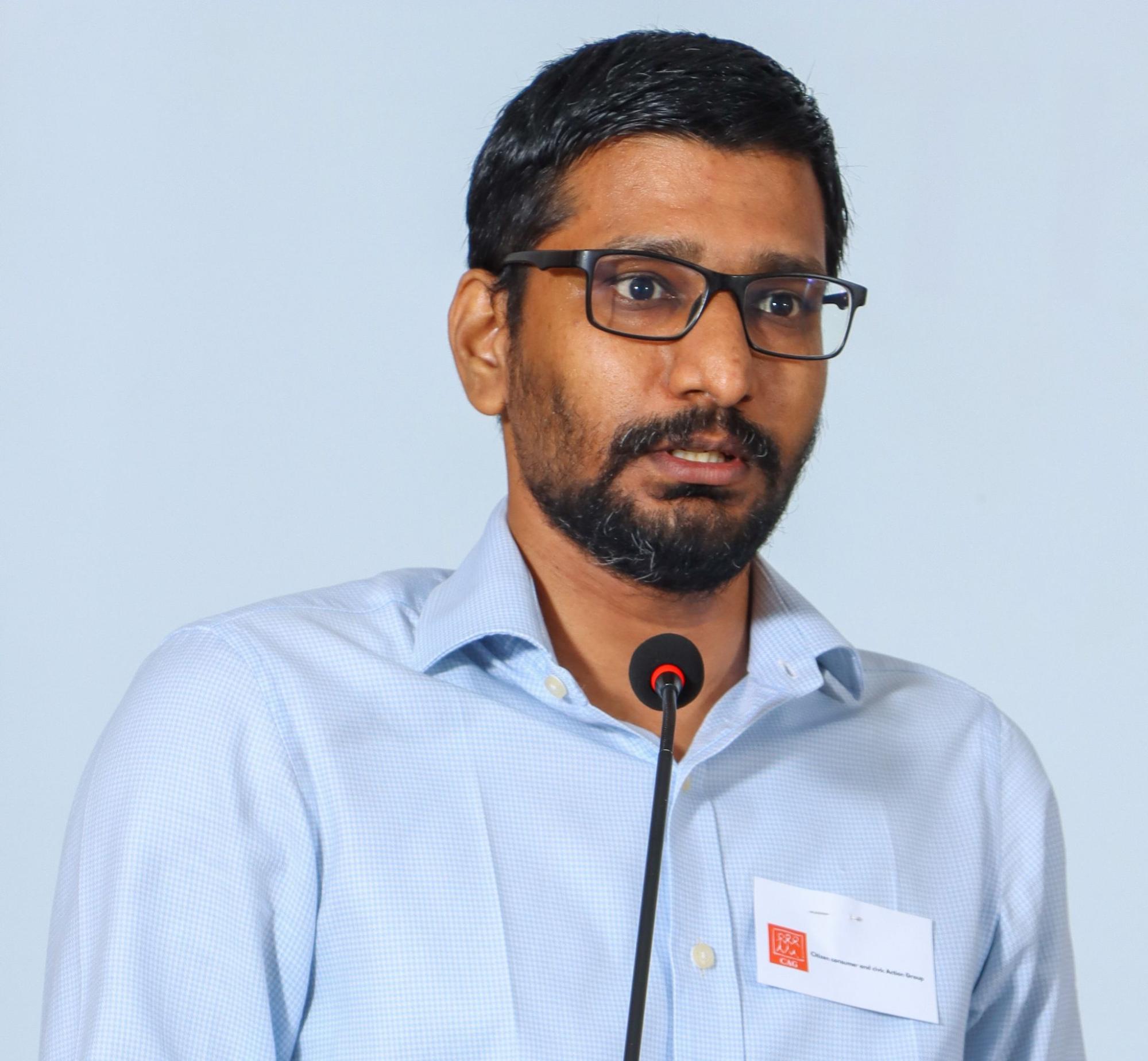
Mr. A. Shankar Prakash
Researcher, Citizen consumer and civic Action Group
Mr. Shankar Prakash explained how CAG is focused on addressing air pollution and climate change by utilizing a multifaceted approach that includes conducting research, advocating for change, and promoting citizen science. This involves monitoring air quality, investigating the effects of air pollution and climate change, and encouraging authorities to adopt cleaner energy sources. Mr. Shankar went on to elaborate how CAG also regularly organises workshops and educational programs to improve participants' knowledge and capacity, and creates informational and educational materials in local languages. He concluded his presentation by explaining that CAG is committed to creating the tools and knowledge pieces required for community outreach and engagement in order to raise awareness about air pollution and climate change.
Session 1
Air pollution & climate change - 2 sides of the same coin
Summary

Ms. Vinuta Gopal
Co-founder & CEO, ASAR
The first session on ‘Air pollution and climate change - two sides of the same coin’ was moderated by Ms. Vinuta Gopal, ASAR. The session delved into discussions around the interconnection between air pollution and climate change; the sources of air pollution such as industries, transportation, construction and demolition debris and burning of waste are the same sources of greenhouse gases contributing to climate change. Therefore, the solutions for both also automatically overlap. Extreme weather events in developing countries have resulted in loss and damage of livelihood, property and persons. Overall, public health is the common and widely impacted outcome of air pollution. This session explained how understanding the nexus between weather, climate variability, air pollution and public health will better prepare us to tackle the effects of climate change.
Nexus between air pollution and climate change - a multifaceted problem

Mr. Bhasker Tripathi
Journalist
Mr. Bhasker Tripathi, a renowned climate journalist, explained why the climate crisis is also a geopolitical issue, touching upon the power politics between developed and developing nations. He said developed countries, after having gone through their industrialisation era much earlier (than developing countries), have historically contributed to the majority of the greenhouse gas emissions. While developing countries are just beginning their industrial growth, it is unjust of the developed nations to ask developing nations to cut down emissions which the former is largely responsible for. He claimed that although individual action is important, the real question should be posed to large polluters such as MNCs, particularly fossil fuel companies and demand redeeming action.
He stressed the importance of posing questions to the government about the big polluters and asking what has been done to make them comply. While he acknowledged the actions taken by the government in shifting to renewables, he added that it is important to ensure a just transition, although it is quite hard to do that in a country like India which remains heavily dependent on coal. Electric vehicles have been promoted as the green solution to the transportation problem, however, it is important to see how the energy needs for EVs are met. Other solutions such as green grid and LPG cooking fuel sound good on paper, but might not be accessible and affordable to all.
He flagged the relaxations granted to industries by Pollution Control Boards (PCB) in the name of ‘ease of doing business’ and called out the fact that compliance can never really be achieved if self-audits are the primary mechanism for ensuring accountability. He also mentioned that we need to focus on the capacity building of PCBs since they see themselves as more of an advisory body rather than an implementing body.
Socio-economic issues in Non-Attainment Cities

Mr. Sundarrajan
Poovulagin Nanbargal
Mr. Sundarrajan started his presentation by giving the audience a reality check that if we believe that Chennai is performing better than other metro cities vis-a-vis air pollution, we are believing an illusion. He mentioned that four cities in Tamil Nadu have been categorised as ‘Non-Attainment Cities’. He revealed alarming facts and stats about Chennai’s air pollution problem caused by thermal power plants, other red-category industries and vehicular congestion. He said that Chennai’s severity of air pollution does not show up in numbers only because of the coastal advantage. However, the role of the sea in absorbing toxic air cannot be relied upon for far too long. He revealed that the number of deaths due to air pollution in Chennai is higher than in other cities due to the numerous thermal power plants. The further expansion of thermal power plants in Tamil Nadu has resulted in over 50000 deaths.
He also added that the problem of air pollution needs to be viewed from a socio-economic perspective since most of these polluting industries, particularly the thermal power plants are located in North Chennai, where the lower income neighbourhoods are situated. He pointed out the cruel reality that while the rich people who live in air-conditioned houses can afford indoor air purifiers, the poor who live in the vicinity of these power plants have no other choice but to breathe toxic air. He also pointed out the caste divide, with North Chennai families typically being from the oppressed castes. This clear divide in unhesitatingly polluting the socio-economically disadvantaged neighbourhoods, makes air pollution and climate change, a class and caste issue.
Session 2
Suffocating Indian cities
Summary
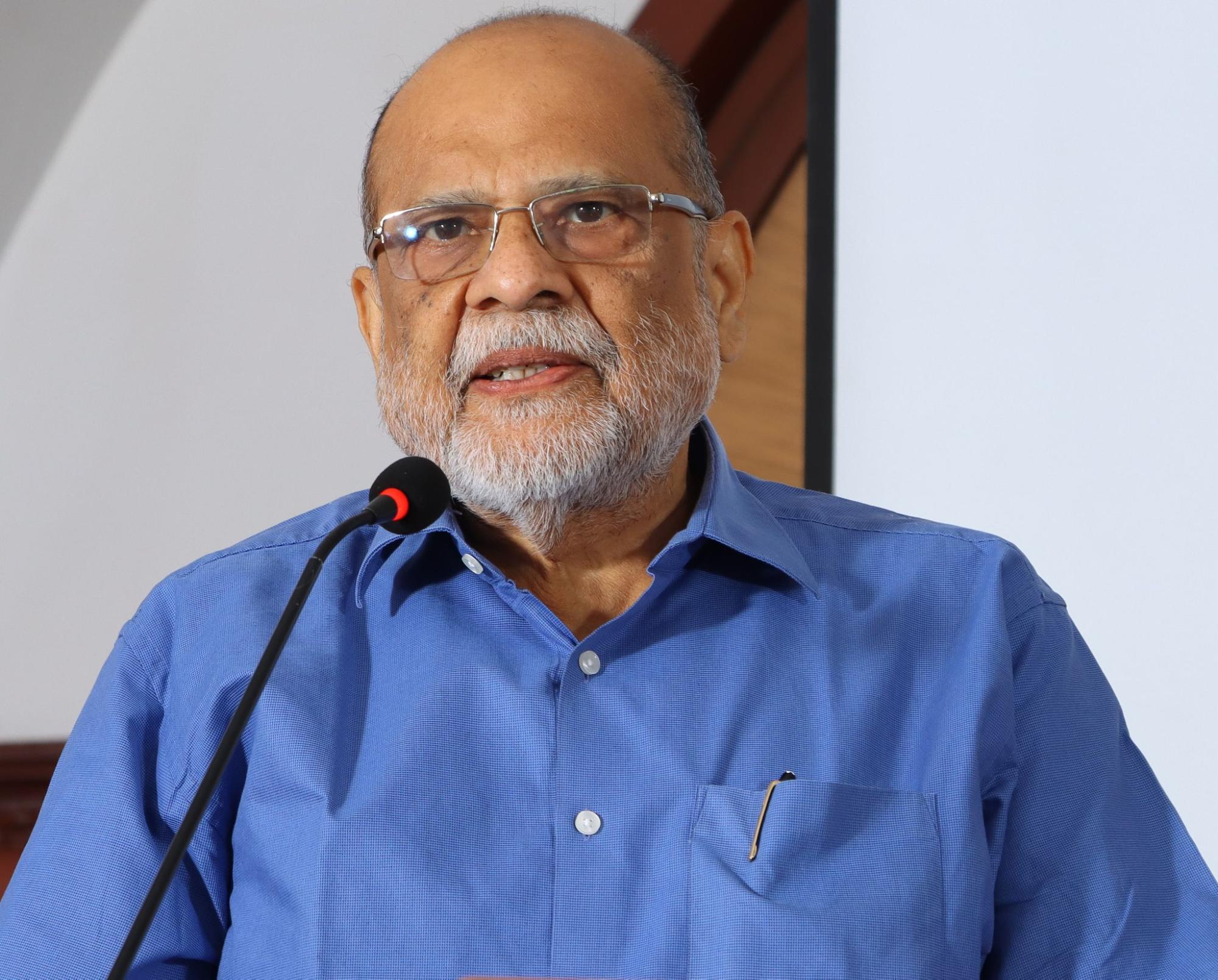
Prof. Sultan Ismail,
Member, State Planning Commission, Tamil Nadu
The second session of the conference was on ‘Suffocating Indian Cities’. Prof. Sultan Ismail, the moderator, began the session on the note that air pollution in India, particularly in megacities and non-attainment cities, requires our immediate and sustained attention. The major sources of air pollution in cities are emissions from vehicles, industries, construction and demolition debris and mismanaged solid waste. Rapid urbanisation and accelerated industrial growth have added to the existing air pollution problem. Among the top 50 most polluted cities in the world, 35 are from India. Therefore, air pollution is a pressing issue in India which needs to be prioritised and addressed immediately.
Vehicular emissions

Mr. Anirudh Narla
Associate Researcher, International Council on Clean Transportation (ICCT)
Mr. Anirudh Narla, briefly explained the study he has undertaken as part of the International Council on Clean Transportation, with the aim of reducing vehicular pollution. He elaborated on ‘The Real Urban Emissions initiative’ (TRUE) which proposes an alternate testing methodology for vehicles to capture and understand the real-world testing of emissions. He explained that since the ‘Pollution Under Control’ certification doesn’t capture the key pollutants which are harmful to the environment, the use of infrared and ultraviolet rays can help detect and capture key pollutants such as nitrous oxide, nitrogen dioxide, hydrocarbons, carbon dioxide and other particulate matter in tailpipe emissions. ICCT has been working with the Clean Air Fund and the Centre for Science and Environment to scientifically measure vehicular emissions. This model helped identify that diesel taxis emit 5 times more than other vehicle groups in London. This model has also been used in Kolkata to screen high-emitting vehicle groups. He explained that the Delhi NCR TRUE remote sensing study will provide scientific evidence for real-time emissions, and identify low-emission and high-emission zones in the city, thus helping policymakers to make decisions based on scientific data.
Industrial pollution in coastal cities

Ms. Gandhimathi
Coastal Action Network
Ms. Gandhimathi from the Coastal Action Network (CAN) addressed the subject of air pollution caused by industries and subsequent health impacts for the people in the surrounding neighbourhoods. She explained how emissions from industries can drastically affect and alter the biodiversity of the region. She also added how the biodiversity of coastal cities, in particular, is at a risk due to industrial pollution. She drew the audience’s attention to the adverse impacts of thermal power plants and mentioned that due to improper storage of waste, the children in the neighbouring areas have developed various kinds of sicknesses. Ms. Gandhimathi emphasised that the calculation of social cost is often overlooked in assessing the impact of any industrial activities.
She enumerated a host of health issues developed by the workers in these industries, the major ones being respiratory, cardiovascular and neurobehavioral problems. She explained how industrial pollution can affect not only the health and livelihoods of people in neighbouring areas but also ocean and marine life. Since oceans play a vital role in the ecosystem as natural buffers, we could be running unimaginable risks by letting this happen. She also elaborated on a case study of shrimp farmers in the coastal districts of Tamil Nadu and the impacts of shrimp farming on water bodies that are significantly altering the marine ecosystem.
Waste(full) cities

Ms. Sumana Narayanan
Senior Researcher, Citizen consumer and civic Action Group
Ms. Sumana from CAG addressed an important issue of mismanagement of waste as a cause of air pollution. She explained the different kinds of waste generated in India and brought the audience’s attention to the fact that over 60% of the waste generated in India is biodegradable waste which can be valuable as a resource if composted properly. A small portion of the waste is recyclable; however, recycling in India continues to be a myth. This is because waste is not segregated at source and therefore all kinds of waste are mixed together while collected and finally dumped in open dumpyards. She stressed that there is a huge difference between landfills and dump yards, although in India these two terms are used interchangeably. Apart from recyclable waste, there is domestic hazardous waste and bio-medical waste which cannot be recycled and needs to be disposed off in an environmentally friendly manner. However in India, since there is no segregation, all kinds of waste are dumped together and often incinerated as the end solution.
Ms. Sumana emphasised the dangers of incinerating waste, particularly plastic waste which releases toxins such as furans when burnt, thus causing air pollution. The air pollution caused by incinerating solid waste is highly hazardous and can cause cancer, TB, asthma and other adverse health issues. She pointed out that those who are affected the most by air pollution caused due to incineration are the socio-economically disadvantaged sections of society since the dump yards are often located in their neighbourhoods. She also touched upon the role of the informal sector in the waste management value chain, particularly, e-waste. The informal waste workers are exposed to various health hazards while working in the dumpyards. She also warned about the dangers of mixed waste, especially mixing bio-medical waste with solid waste in dump yards. Since urban local bodies cannot handle mixed waste in such large quantities every day, they choose the easy but unsustainable option of burning it. She highlighted that our systems are designed for linearity where overproduction and overconsumption are constantly encouraged. She therefore stressed the importance of promoting a circular economy and zero waste models which discourage use and throw behaviours.
Session 3
Indian policy responses to Air Pollution
Summary

Mr. Nivit Kumar Yadav
Programme Director, Centre for Science and Environment
This session delved into the scope and mandate of the National Clean Air Program (NCAP) and analysed whether sufficient budgetary allocation has been made to the programme. The ancillary issues and factors impeding the effective implementation of NCAP and the performance of Central Pollution Control Boards (CPCB) were examined. The policy was also examined through the lens of subalterns, particularly women and indigenous communities. Mr. Nivit Kumar Yadav began the session by explaining how in order to tackle air pollution, the Indian government has implemented the National Clean Air Program (NCAP) through the Ministry of Environment, Forest and Climate Change (MoEFCC). The program aims to address the issue in a comprehensive manner and target a reduction of 20-30% of particulate matter(PM)pollution by 2034, keeping 2017 as the base year. 432 non-attainment cities have been identified and asked to submit proposals for reducing air pollution. Despite NCAP having all the above provisions in place, there has been a lapse in the implementation phase; and therefore the results of the program have been a mixed bag. He added that this workshop is therefore vital to analysing the effectiveness of NCAP and identifying limitations and ways to overcome them.
CPCB Action plans in NAC

Dr. R. Ethirajan
Environmental Engineer, Tamil Nadu Pollution Control Board
Dr. R. Ethirajan began the session by giving a presentation on the National Action Plan of the Central Pollution Control Board (CPCB) for managing non-attainment cities. He discussed the three major acts (The Water Act 1974, The Air Act 1981, and the EP Act 1986) that the CPCB and the State Pollution Control Boards (SPCBs) implement to protect the environment. He explained the functions of the CPCB, MoEFCC, and state government in overseeing the work of the SPCBs. He also went into detail on the Air Act and the organisational structure of the Tamil Nadu Pollution Control Board (TNPCB). Dr. Ethirajan discussed the major components of air quality management, including setting air quality standards, monitoring air pollution, identifying sources of air pollution, and implementing strategies to reduce air pollution. The government monitors air quality through the National Ambient Air Quality Monitoring program, with data collected from 883 stations across 28 states. The CPCB also publishes an Air Quality Index and uses real-time monitoring stations and continuous air quality monitoring stations. Dr. Ethirajan also discussed the National Clean Air Program (NCAP), which is aimed at reducing PM pollution by 20-30% by 2024, with identified non-attainment cities having source apportionment studies and action plans to reduce pollution. He concluded by explaining how the government operates through committees at the centre and state levels to ensure that the NCAP goals are achieved.
Viewing air pollution and policies through the gender lens

Dr. Pallavi Pant
Head of Global Health, Health Effects Institute
Dr. Pallavi Pant highlighted the absence of gender as a factor in discussions about air pollution. While there was a lot of talk about how air pollution affects health, environment, the economy, etc., the gender aspect of it barely receives the attention it deserves. She further asked us to introspect about who is doing the chores at home, who cooks, who drops kids at school and takes care of them etc. She went on to explain that women, particularly those of childbearing age and pregnant women, are disproportionately affected by air pollution and household pollution due to their traditional roles in the home. She added that the usage of wood, coal, animal dumps etc as household fuel has an impact on the respiratory health of women. Hence it becomes vital that we transition to cleaner fuels for women, so that they can step out of the house and take part in other roles contributing to the economy. She emphasised the importance of analysing gender roles in finding solutions to air pollution and called for more focus on the gender aspect in future discussions and policies. Ms. Pallavi also expressed her hope that future policies will consider the gender perspective and include gender-specific data analysis.
Status of implementation of NCAP and roadblocks

Mr. Sunil Dahiya
Analyst, Centre for Research on Energy and Clean Air
Mr. Sunil Dhaiya discussed the implementation status of the National Clean Air Program (NCAP) and the roadblocks faced in its implementation. He mentioned that NCAP was implemented in 2019 after multiple consultations and revisions by MoEFCC and CPCB, but there are still roadblocks to its implementation. He talked about 4 different domains of NCAP with multiple indicators, including improving air quality monitoring mechanisms at the state and national levels. However, out of 26 cities, only 10 have submitted state-level action plans, and Tamil Nadu has yet to submit them. Also, despite a delay of 3 years, the base studies such as source apportionment and emission inventory have not been completed, which are crucial for strategic interventions. He further discussed the four different domains of NCAP, including strengthening the air quality monitoring mechanisms, but noted that the majority of the state-level action plans have not been submitted. He also pointed out that despite progress in some areas, the implementation of NCAP is failing.
Mr. Dhaiya highlighted the lack of transparency in the committees set up to oversee the program, as well as the need for a different approach to industrial monitoring and setting standards for industries. He referred to a report by his organization, CSE, which outlines the status of NCAP and its progress in achieving its goals. He highlighted that despite multiple revisions and consultations, NCAP is facing difficulties in implementation. The NCAP is also facing problems with data availability and the integration of decision support systems. Mr.Dhaiya concluded by saying that NCAP will not result in significant improvements unless there is a comprehensive mechanism for air quality management, stricter punitive actions on polluters, and a stratified national air quality approach.
Securing India's database for Air Pollution
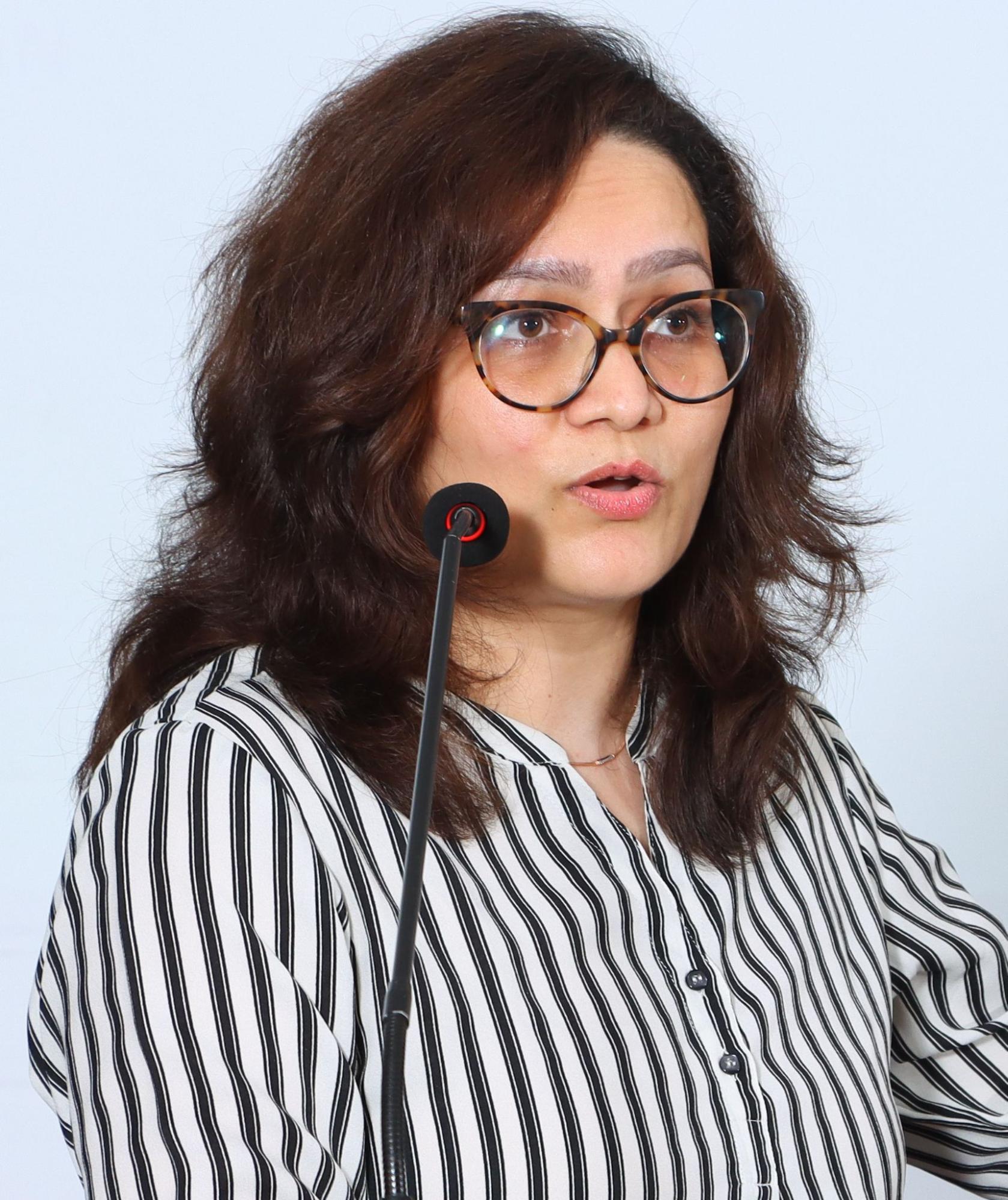
Dr. Pratima Singh
Senior Research Scientist, Center for Study of Science, Technology and Policy
Dr. Pratima Singh discussed the topic of "Securing India's Database for Air Pollution". She elaborated on the steps to manage the air pollution problem, with the first step being to set a goal, which should be to provide clean breathing air for all. The next step is baseline air quality assessment, followed by air quality monitoring and management; the fourth step is intervention strategies and the final step is action plan implementation and evaluation. She pointed out that NCAP lacked a scientific approach and a robust emission inventory or source apportionment study, as most pollution boards in India do not have state-of-the-art laboratories to carry out such studies.
Dr Singh also emphasised the need for high-quality data from authentic sources that can be used for modelling and research purposes. For this, she stressed the importance of having a good network of monitoring stations and conducting emission inventory and source apportionment studies to identify the activities and sectors responsible for pollution. Dr. Pratima went on to explain the various ways of collecting data, such as through monitoring networks, manual emissions status, and continuous air quality management systems (CAQMS). While the data currently available is collected by the state-level Pollution Control Boards and the government, institutions, and industries, this data is limited to research and compliance and not for the larger picture of understanding the impact of air pollution on health. Therefore, she emphasised the need to use data for the right purposes and not just to show numbers. Pratima highlighted the challenges in air pollution monitoring in India. Despite the need for 4000 monitors, the country only has 1387 monitors. The distribution of these monitors is also not even, with over 33% of real-time monitors concentrated in Delhi alone. The cost of setting up a monitoring station is also high, requiring an investment of over Rs. 4000Cr for 4000 monitors. This highlights the need for more investment and better planning in order to effectively monitor and address air pollution in India.
Dr. Singh said that there is a need for a central database of emission inventory studies in India which can be accessed by researchers, policymakers and the public to better understand the air pollution problem in India and to develop effective strategies for reducing air pollution. Dr. Singh stressed the need for young researchers to create a standard template for air quality data collection and for institutions to educate policymakers and various departments about the data required for effective air quality management. She also encouraged the creation of country-level databases to better understand and manage the air pollution problem in India.
Session 4
Sustainable solutions for Air Quality Management
Summary

Mr. Dharmesh Shah
Legal Initiative for Forest and Environment
Mr. Shah began explaining how air pollution must not just be viewed as prevalent only in highly populated and urbanised areas but as something that has also reached the purest uninhabited corners of the world. Air pollution is not a new issue in India, but one that has gained a lot of traction recently due to the rapidly worsening of air quality from anthropogenic sources. It results not only in individual and environmental loss but also affects the country’s economy, labour force and public health.
Mr. Dharmesh discussed the possible sustainable solutions to tackle air pollution at source, especially emissions from vehicles, fossil fuels and solid waste. While managing the problem at source, parallelly, there is a growing need to conduct health surveillance and mapping to keep track of the impacts on public health. The point about how India’s policy framework lags behind technological progress and the need for sustainable solutions to a modern problem which requires substantial political will to be implemented effectively was discussed.
India’s AQM - pollution prevention and control infrastructure

Dr. Abinaya Shekar
Senior Research Associate, Centre for Policy Research
Dr. Abinaya Shekar discussed the evolution of air quality management (AQM), the issues and capacity of regulatory agencies, and the control measures that are taken. The objective of NCAP is to attain acceptable national ambient air quality standards. The standard PM2.5 levels that sensitive areas are required to maintain are designated by the State Government. However, none of the states have a clear definition of sensitive zones. Furthermore, the 2009 standards are considered lenient compared to 1994 standards. Dr. Abinaya raised concerns about the capacity of regulatory authorities, citing that more than 50% of technical posts in the country are currently vacant and there is a lack of uniform pattern of assessment and selection criteria for these posts across the country.
She emphasised the importance of providing scientific evidence to implement effective control measures and called for a transparent and scientific approach to determining the National Ambient Air Quality Standards (NAAQS), taking into consideration the health evidence, factors used in similar cities, and involving the public in the decision-making process. Dr. Abinaya suggested that a revision of the AQM and NAAQS should be carried out in a periodic manner and that an airshed approach should be adopted to address the transport of pollutants from one state to another. She concluded by recommending that India should learn from cities like Mumbai and reduce local sources of pollutants, such as paving roads and banning diesel vehicles.
Zero waste cities

Mr. Shibu Nair
Regional Organics Campaigner, Global Alliance for Incinerator Alternatives
In the presentation given by Mr. Shibu Nair, the topic of biodegradable waste management in municipalities, both in India and other countries was discussed. He highlighted the dangers of burning waste as a means of cleansing, as it contributes to pollution. Mr. Shibu pointed out that the current trend in waste management is decentralisation, as people are rejecting centralised waste management plants in their neighbourhoods. This has led to cities setting up small-scale decentralised composting facilities. The promotion of this system creates more businesses, and jobs and improves the local economy, as seen in Kerala.
Mr. Shibu criticised the approach taken in Kochi where biodegradable waste is collected, composted, dried, burned, and then dumped in a mine or released into the air, adding to pollution. He emphasised the need for a simpler solution that eliminates transportation and reduces pollution. Mr. Shibu concluded by emphasising the importance of promoting home compost systems, kitchen and urban gardening, and organic farming to solve the issue of organic waste management in a sustainable manner.
Transition to renewables
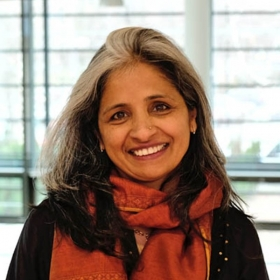
Dr. Bhargavi Rao
Senior Fellow/ Trustee, Environment Support Group
Dr.Bhargavi Rao emphasised the significance of understanding the developments in the renewable energy sector while discussing air pollution and climate change. She stressed the need to assess the impact of renewable energy projects on local communities and the environment. She went on to talk about the negative impacts of the Pavagada solar park, a 2000 MW solar project in Karnataka, India. According to her, the project has resulted in the displacement of local communities, and loss of access to fields, grazing pastures, schools, roads, etc. The small and marginalised farmers received only one-time payments and have limited access to resources, resulting in poverty and increased mortality rates. Local people were not hired for installation work, with migrants being hired instead.
Dr. Bhargavi pointed out that the region has a lot of pastoral jobs, but pastoral communities have lost access to their livelihoods. Additionally, despite being located near solar panels, the local communities still don't have access to electricity. She concluded by saying that it is important to ensure the participation of local people in such projects to minimise its negative impacts.
Sustainable mobility to combat air pollution
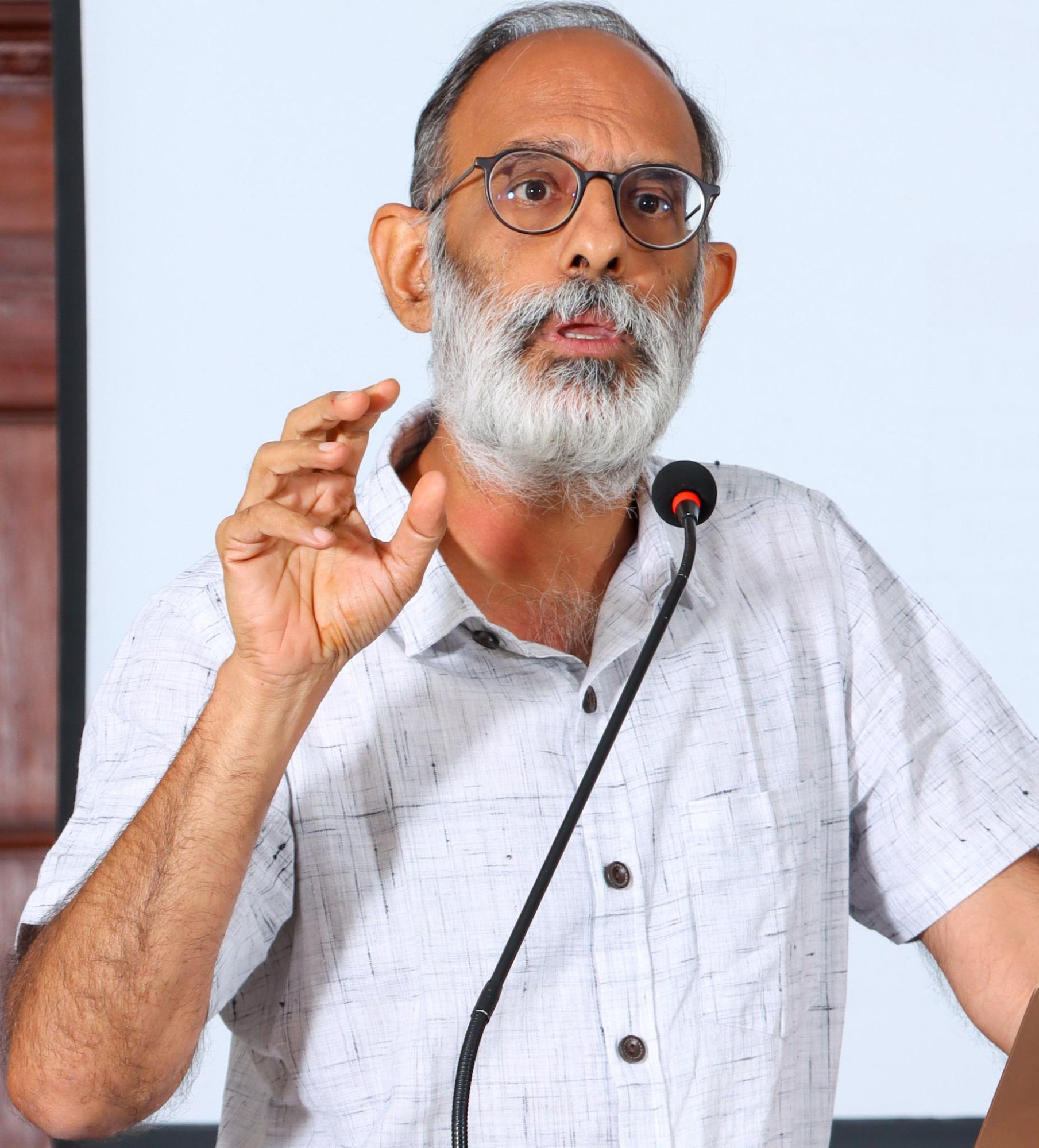
Mr. Ranjit Gadgil
Programme Director, Parisar
Mr. Ranjit Gadgil spoke on sustainable mobility as a solution to combat air pollution. He highlighted that the cumulative effect of transport on air pollution is increasing and that there is a reasonable argument for promoting electric vehicles (EVs) in cities due to their exposure to air pollution. He also emphasised the importance of demand management and reducing waste in order to combat air pollution.
Mr. Ranjit pointed out some positive initiatives in cities, such as Pune, which has adopted a comprehensive bicycle plan, and urban street design guidelines, and organises a pedestrian day annually. However, he also mentioned the challenges faced in implementing sustainable mobility, such as the need to reduce car trips and shift to walking, cycling, and public transport.
Mr. Ranjit also discussed the downsides of car-centric planning, its ecological impact, and how this is a result of a misunderstanding of the use of flyovers among city planners. He emphasised the importance of demand management, such as parking policies, to discourage car usage and encourage sustainable mobility. He concluded by highlighting the need for a significant increase in the number of buses in India to move towards sustainable mobility.
Session 5
Sustainable citizen accounts
Summary
In addition to the technical sessions by experts, this session was dedicated to citizens sharing accounts of sustainable lifestyles.

Ms. Janani Venkitesh
Member, Residents of Kasturbanagar Association
Ms. Janani Venkitesh, member of Residents of Kasturbanagar Association (ROKA), shared her field-level work on promoting source segregation of waste. She narrated how ROKA volunteers have successfully diverted 1.5 metric tons of biodegradable waste from landfills through collection drives. Though they represent Kasturbanagar, their efforts extend to a few other cities and municipalities. She recollected Dr.Ismail’s speech and concurred with him that while dealing with waste we should think of it as resource management rather than solid waste management. To promote sustainable consumption, waste should be considered as a valuable resource. While there are many organisations working to build awareness about climate change, she stressed that ROKA works towards monitoring and implementation of policies. ROKA’s activities aim to include kids and adults in the community and also include housekeeping staff who largely deal with household waste.
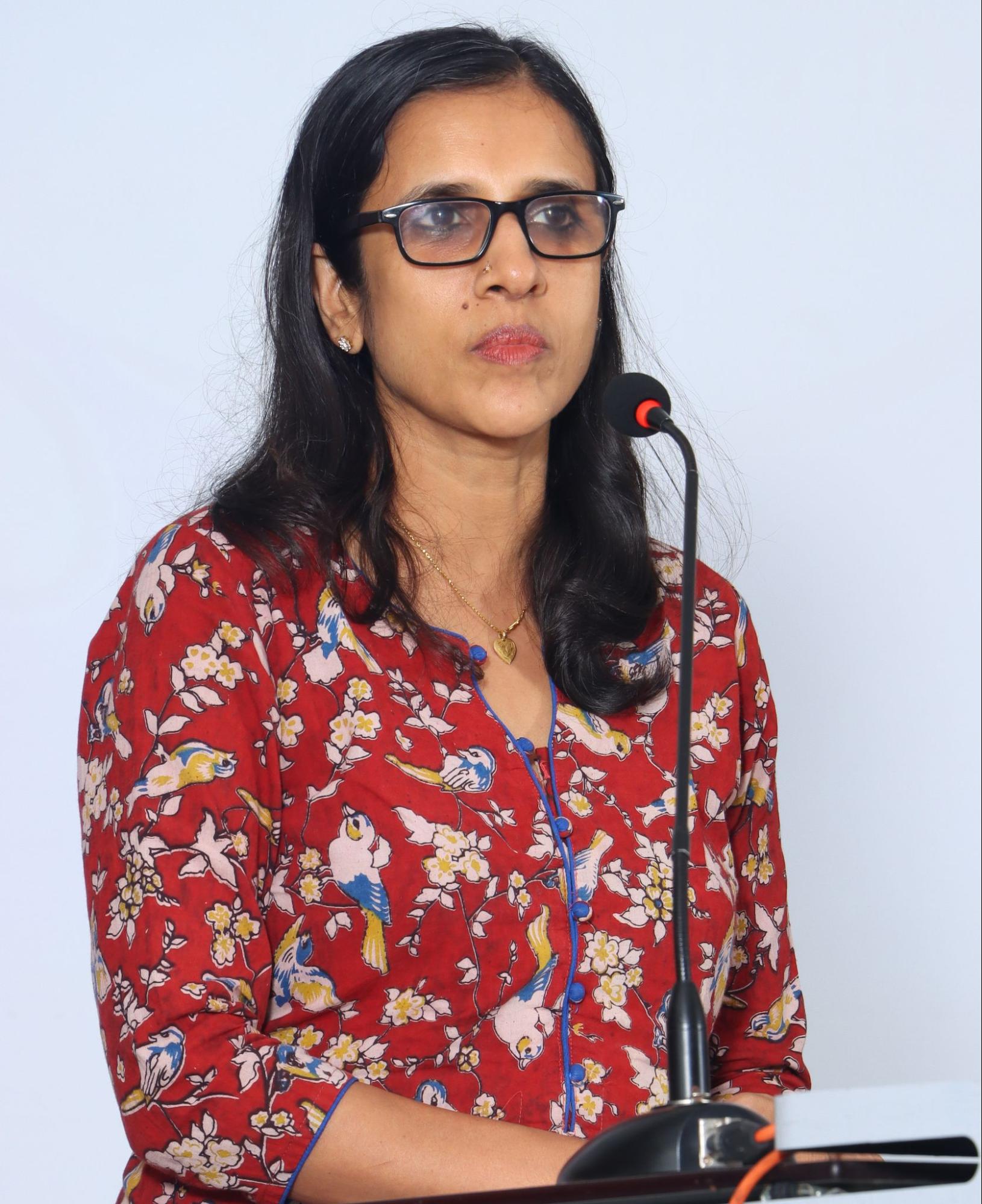
Ms. Nina Subramani
Warrior Moms
Ms. Nina Sumbramani is from Warrior Moms, a collective led by women in selected states, committed to advocating for clean air and a countrywide healthy air quality index in line with WHO standards for children. She highlighted how air pollution is disproportionately distributed within Chennai’s geography. She and other mothers across the country have launched a ‘know your rights campaign’ initiative to raise awareness and amplify the health effects of air pollution. As most rural households can’t afford LPG cylinders, air pollution at the household level caused by burning biomass fuel affects mothers and children.
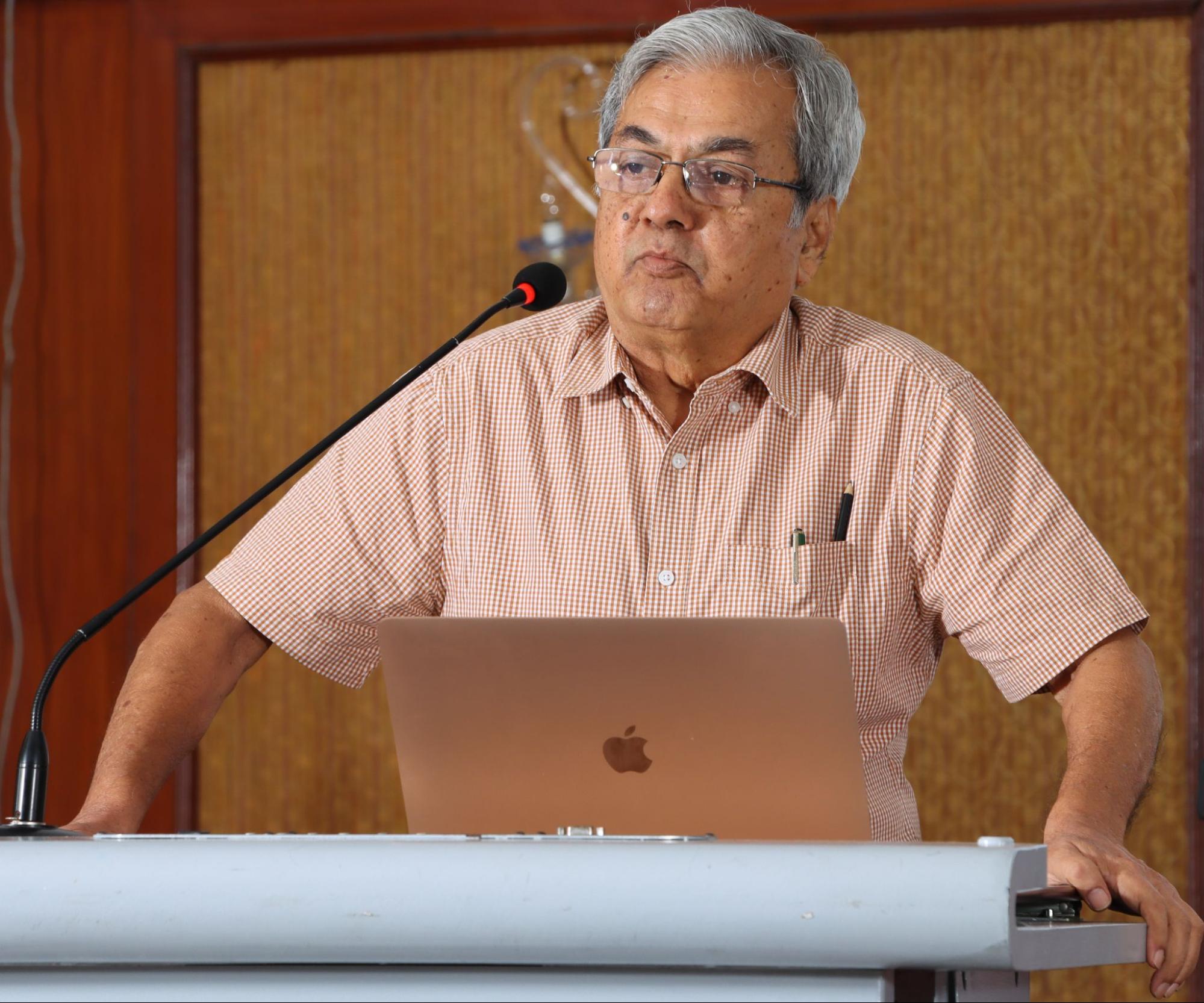
Mr. Suresh
Environmental Enthusiast
Mr. Suresh is a self-taught environmental enthusiast who has taken it upon himself to find household-level solutions to environmental problems. He has successfully implemented projects such as rainwater harvesting, solar roof-top, biogas generation, terrace gardening, hydroponics, air-to-water generation, solar scooters and wastewater recycling in his house. He explained how he has shared his experiences and household-level environment-friendly solutions with over 25,000 people and has given over 500 talks. He is of the opinion that individuals should not expect the governments to find the solutions; instead, they should find solutions themselves.
Vote of Thanks and Conclusion
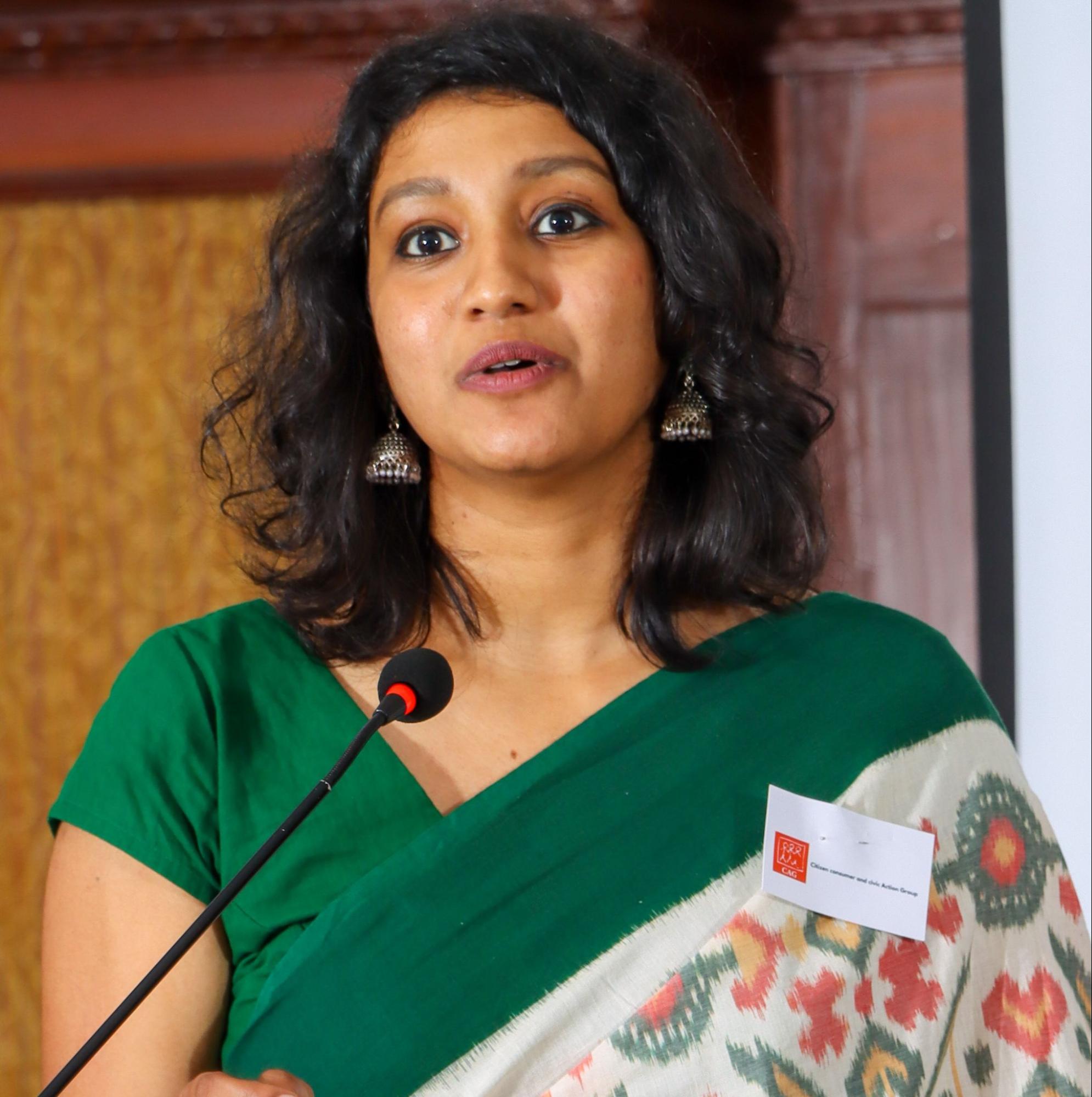
Ms. Madhuvanthi R
Researcher, Citizen consumer and civic Action Group
Madhuvanthi from CAG thanked all the speakers for sharing their views, suggestions, and experiences on technical and policy issues related to air pollution. The conference helped in understanding the interconnectedness of air pollution and climate change and how the socioeconomic dimensions underlie this intersection. All the speakers concurred that in the persistent conflict between economy and ecology, economy always wins. However, it was also highlighted that since air pollution and climate change impact public health and subsequently affects the economy of the country, taking control measures to combat air pollution and mitigating climate change effects is also beneficial from an economic point of view. The discussions also helped us understand in-depth about various sources of pollution and the challenges in regulating them. The conference also analysed the Indian policy responses to air pollution, particularly the National Clean Air Programme, its scope, and the roadblocks in its implementation. Due importance was also given to inclusive and participatory decision-making by discussing the importance of viewing the problem of air pollution through the gender lens. Rather than stopping with enumerating the issues, the conference also provided an arena to suggest some potential sustainable solutions and pathways in the context of transportation, waste management, fossil fuels and the process of transitioning to renewables. The conference concluded with 3 responsible citizens who practise sustainable initiatives in their daily lives explaining how it is possible to take action against air pollution at an individual level while waiting on macro level solutions from the government.

